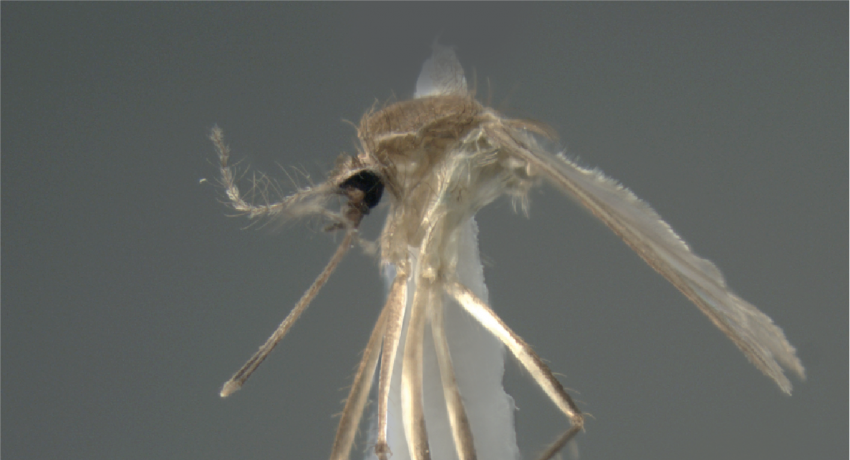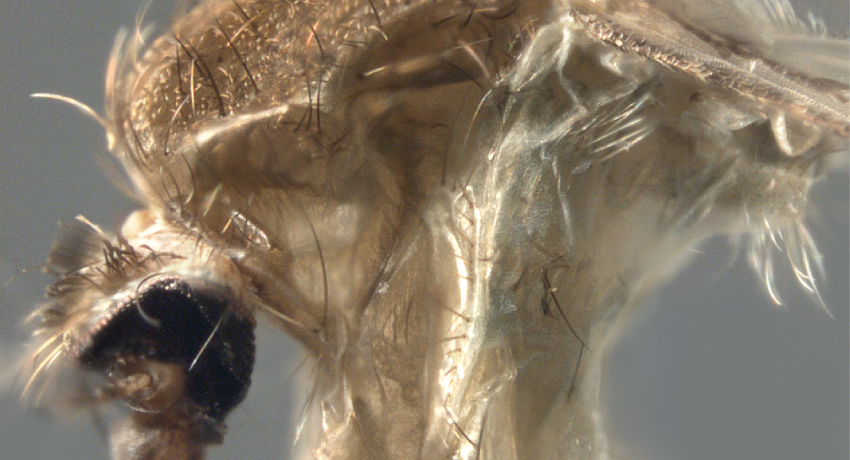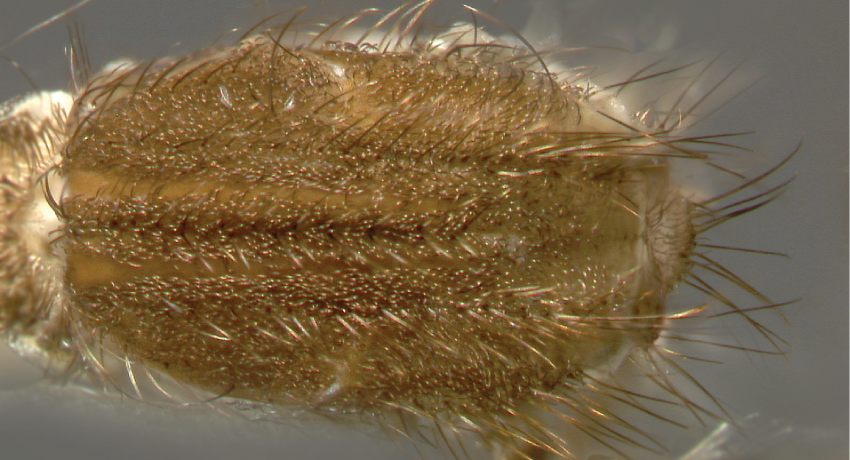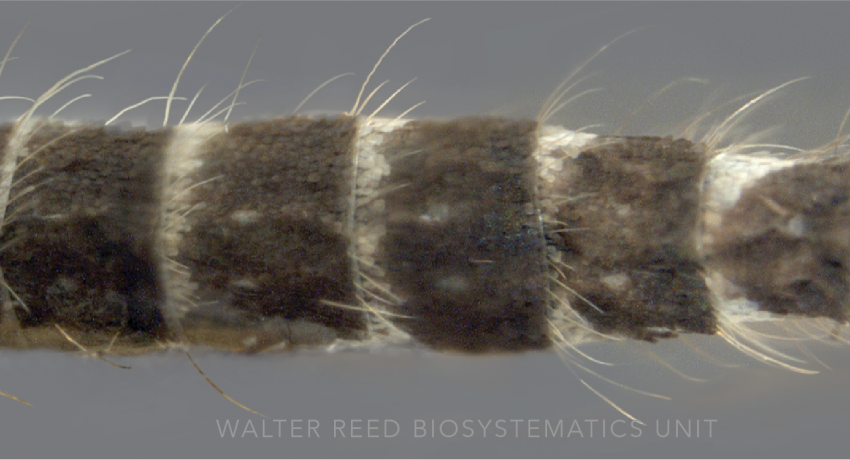NEOTROPICAL & NEARCTIC REGION
Etymology: black palpus (L)
Culex nigripalpus, is unusually colorful for a Culex species, sporting black scales and bronze to metallic blue-green reflections on the abdomen, with dark, reflective bronze to metallic blue-green scaled legs. It is placed in the Apicinus Subgroup (Pipiens Group).
Type locality: St. Lucia Island (Lesser Antilles)
Type depository: Type non-existent (NE)
DIAGNOSTIC CHARACTERS (Click photos to view; mouse over and click large photo to zoom in.)
ADULT (illustrated): Head: Proboscis dark-scaled, paler ventrally on basal half. Thorax: Head with narrow curved scales dorsally, and long erect forked scales; mesepimeron without median patch of white scales; acrostichal setae present; scutellar midlobe with basal patch of fine dark brown scales. Legs: Ta-I–III all dark-scaled. Abdomen: II,III-Te with indistinct or very narrow basal pale bands; VII-Te mostly dark, with large lateral patches of white scales; VII,VIII-Te sometimes also with narrow basal white bands.
LARVA (not illustrated): Head: Seta 1-A large, inserted on apical 0.34 of antenna; setae 5–7-C with ≥3 aciculate branches; seta 6-C 3,4 branched. Thorax: Integument with tiny spicules; seta 3-P ≥0.67 x length of 1-P; seta 1-M very small, equal in length to 2-M. Terminal segments: Seta 1-S tufts inserted ventrally and laterally, not in even row; seta 1-S basal-most tuft usually single, length nearly 2 x width of siphon at insertion; seta 2-X 2,3 branched, shorter than 3-X; siphon without small spines near apex; siphon index 8.0.
TAXONOMIC KEYS
Carpenter & LaCasse 1955
Dodge 1966
Darsie & Day 2003
Darsie & Ward 2005
Becker et al. 2010
Harrison et al. 2016
![]()
WRBU – Culex (Cux.) - Neotropical Region – Larva
Exemplar DNA sequences
Cx. nigripalpus COI: KM592991–92, KM593008, KM593058, KP211381–93, KY859885–92
BIONOMICS
Immatures
Population peaks of Cx. nigripalpus are closely related to rainfall. Differing habitats correspond to geography—in northern populations females typically lay in large rafts of 90–210 eggs in freshly flooded ditches and agricultural seepage pits, targeting sites that flood infrequently, but hold water for 10–14 days. In the southern Atlantic and Gulf coasts, immatures are sometimes found in crabholes filled with brackish water, and in the tropics, immatures occupy polluted water pools and bromeliad axils. Immatures have occasionally been reported in wheel ruts and artificial containers.
Adults
Female Cx. nigripalpus host seek from early evening to late into the night. Although considered exophagic, at high densities, females are known to enter buildings to seek out blood meals. The host preferences of Cx. nigripalpus vary by season—whereas females feed on birds in winter and spring, they feed on large mammals (domestic livestock and people) during summer and fall.
DISTRIBUTION NOTES
Anguilla, Antigua & Barbuda, Bahamas, Barbados, Belize, Bolivia, Brazil, Cayman Islands, Chile, Colombia, Costa Rica, Cuba, Curacao, Dominica, Dominican Republic, Ecuador, El Salvador, French Guiana, Grenada, Guadeloupe, Guatemala, Guyana, Haiti, Honduras, Jamaica, Martinique, Mexico, Montserrat, Nicaragua, Panama, Paraguay, Peru, Puerto Rico, Saint Kitts & Nevis, Saint Lucia, Saint Vincent & the Grenadines, Suriname, Trinidad & Tobago, United States (continental), Venezuela, Virgin Islands.

WRBU VECTOR HAZARD REPORTS
VHR: Mosquitoes of the Caribbean
View other WRBU Vector Hazard Reports
Available GIS Models
Cx_nigripalpus_Dornak_1 South & Central America
IMPORTANT REFERENCES (full citations below)
Theobald 1901c: 322 (M*, F*)
Gerry 1932 (F*)
Coutinho 1941 (L anomaly)
Dodge 1945: 166 (L*)
Yamaguti & LaCasse 1951c: 41 (M*, F*, L*)
Lane 1953: 348 (M*, F, P*, L*)
Carpenter & LaCasse 1955: 282 (M*, F*, L*; keys)
Dodge 1966: 370 (1st instar L*; key)
Bram 1967a: 84 (M*, F, L)
Belkin 1968b: 18 (type information)
Belkin et al. 1970: 70 (M*, F, P*, L*)
Nayar 1982 (bionomics, physiology)
Chadee & Haeger 1986 (E*)
Darsie & Day 2003: 101 (P*; taxonomy, key)
Darsie & Day 2004: 110 (L*; taxonomy)
Darsie & Ward 2005 (F*, L*; keys, distribution)
Becker et al. 2010: 384 (F*, L*; key, bionomics, taxonomy, distribution)
Berti et al. 2015 (distribution; Venezuela)
Harrison et al. 2016 (F*, L*; keys, distribution)
CURRENT SYNONYMS
syn. palus Theobald
1903a: 194 (M*, F). Type locality: Barbados, [Lesser Antilles] (NHMUK). References: Belkin 1968b: 19 (lectotype desig.).
syn. similis Theobald
1903a: 207 (F). Type locality: Red Hills, Kingston, [Surrey], Jamaica (NE). References: Belkin 1968b: 20 (type info.).
syn. biocellatus Theobald
1903a: 224 (F; flavipes var.). Type locality: Trinidad [Trinidad & Tobago] (NHMUK). References: Stone 1957 (1956)a: 340 (tax.); Stone et al. 1959: 252 (syn.); Belkin 1968b: 13 (taxonomy).
syn. microsquamosus Theobald
1905: 407 (M*, F, L*). In: Grabham 1905. Type locality: Rio Cobre Canal Dam, near Spanish Town, [Middlesex], Jamaica (NHMUK). References: Belkin 1968b: 17 (lectotype designation).
syn. carmodyae Dyar & Knab
1906d: 210 (L*). Type locality: [San Francisco Mines], Santo Domingo [Dominican Republic] (USNM). References: Stone & Knight 1957a: 44 (lectotype designation).
syn. mortificator Dyar & Knab
1906d: 210 (L*). Type locality: Zent, Costa Rica (NE). References: Stone & Knight 1957a: 53 (type information).
syn. factor Dyar & Knab
1906d: 212 (L*). Type locality: Tehuantepec, [Oaxaca], Mexico (USNM). References: Stone & Knight 1957a: 49 (lectotype designation).
syn. regulator Dyar & Knab
1906d: 213 (L*). Type locality: Santo Domingo [Dominican Republic] (USNM). References: Stone & Knight 1957a: 55 (lectotype designation).
syn. microannulata Theobald
1907: 481 (M*; Trichopronomyia). Type locality: Stanley Town, New Amsterdam, [Berbice], British Guiana [Guyana] (NHMUK). References: Belkin 1968b: 17 (type information).
syn. proximus Dyar & Knab
1909a: 38 (M*). Type locality: [Taboga Island], Panama (USNM). References: Stone & Knight 1957a: 55 (lectotype designation).
syn. caraibeus Howard, Dyar & Knab
1913 (1912), Fig. 333 & 1915: 257 (F, L*). Type locality: Barbados [Lesser Antilles] (USNM). References: Stone & Knight 1957a: 45 (lectotype designation).
syn. prasinopleurus Martini
1914: 68 (M*, F). Type locality: Santiago de Cuba, [Oriente], Cuba (NHMUK). Refs.: Mattingly 1955c: 31 (lectotype designation).
syn. azuayus Leví-Castillo
1954c: 264 (M*, F, P*, L*). Type locality: Zhurucuchu, Azuay, Ecuador (?USNM). Refs.: Bram 1967a: 84 (synonymy).
CITED REFERENCES
Becker, N., Petrić, D., Zgomba, M., Boase, C., Madon, M., Dahl, C., & Kaiser, A. (2010). Mosquitoes and their control (Second ed.). Berlin Heidelberg: Springer-Verlag.
Belkin, J.N. (1968b). Mosquito studies (Diptera, Culicidae). IX. The type specimens of New World mosquitoes in European museums. Contributions of the American Entomological Institute, 3(4), 1–69.
Belkin, J.N., Heinemann, S.J., & Page, W.A. (1970). The Culicidae of Jamaica (Mosquito studies. XXI) Contributions of the American Entomological Institute, 6(1), 458.
Berti, J., Guzmán, H., Estrada, Y., & Ramírez, R. (2015). New records of mosquitoes (Diptera: Culicidae) from Bolívar State in South Eastern Venezuela, with 27 new species for the state and 5 of them new in the country. Frontiers in Public Health, 2, 10.
Bram, R.A. (1967a). Classification of Culex subgenus Culex in the New World (Diptera: Culicidae). Proceedings of the United States National Museum, 120(3557), 1–122.
Carpenter, S.J., & LaCasse, W.J. (1955). Mosquitoes of North America (North of Mexico). Berkeley, Los Angeles: University of California Press.
Chadee, D.D., & Haeger, J.S. (1986). A description of the egg of Culex (Culex) nigripalpus Theobald from Florida, with notes on five egg rafts (Diptera: Culicidae). Mosquito Systematics, 18(3,4), 288–292.
Coutinho, J.O. (1941). Sôbre uma curiosa anomalia em uma larva de Culex (C.) nigripalpus Theobald, 1901 (Diptera, Culicidae). Revista Brasileira de Biologia (Rio de Janiero), 1(3), 343–344.
Darsie, R.F., Jr., & Day, J.F. (2003). Studies of the genus Culex Linnaeus in Florida. I. Redescription of the pupae of Culex nigripalpus Theobald and Cx. tarsalis Coquillett, vectors of St. Louis encephalitis, and a key to pupae of Culex species in the eastern United States (Diptera: Culicidae). Proceedings of the Entomological Society of Washington, 105(1), 100–107.
Darsie, R.F., Jr., & Day, J.F. (2004). Studies of the genus Culex in Florida. II. Redescription of the fourth instar of Culex nigripalpus. Journal of the American Mosquito Control Association, 20(2), 110–114.
Darsie, R.F., Jr., & Ward, R.A. (2005). Identification and geographical distribution of the mosquitoes of North America, north of Mexico. Gainesville, FL: University Press of Florida.
Dodge, H. R. (1945). Notes on the morphology of mosquito larvae. Annals of the Entomological Society of America, 38, 163–167.
Dodge, H. R. (1966). Studies on mosquito larvae II. The first-stage larvae of North American Culicidae and of world Anophelinae. Canadian Entomologist, 98, 337–393.
Dyar, H.G., & Knab, F. (1906d). The larvae of Culicidae classified as independent organisms. Journal of the New York Entomological Society, 14, 169–230.
Dyar, H.G., & Knab, F. (1909a). On the identity of Culex pipiens Linnaeus (Diptera, Culicidae). Proceedings of the Entomological Society of Washington, 11, 30–39.
Gerry, B. I. (1932). Morphological studies of the female genitalia of Cuban mosquitoes. Annals of the Entomological Society of America, 25, 31–75.
Harrison, B.A., Byrd, B.D., Sither, C.B., & Whitt, P.B. (2016). The mosquitoes of the Mid-Atlantic Region: an identification guide (Vol. 1). Madison Heights, MI: Publishing XPress.
Howard, L.O., Dyar, H.G., & Knab, F. (1913). The mosquitoes of North and Central America and the West Indies. (Vol. II) (1912). Washington, D.C.: Carnegie Institution of Washington.
Lane, J. (1953). Neotropical Culicidae (Vols. I, II). São Paulo: University of São Paulo.
Leví-Castillo, R. (1954c). Atlas de los anofelinos Sudamericanos Revista Ecuatoriana de Entomología y Parasitologia, 2(1,2), 263–267.
Martini, E. (1914). Some new American mosquitoes. Insecutor Inscitiae Menstruus, 2, 65–76.
Mattingly, P.F. (1955c). Mosquitoes (Diptera: Culicidae) from the Tropical Institute at Hamburg. Proceedings of the Royal Entomological Society (B), 24, 27–33.
Nayar, J.K. (1982). Bionomics and physiology of Culex nigripalpus (Diptera: Culicidae) of Florida: an important vector of diseases. Florida Agricultural Experiment Stations Bulletin, 827, 1–73.
Stone, A. (1957a). Corrections in the taxonomy and nomenclature of mosquitoes (Diptera, Culicidae). Proceedings of the Entomological Society of Washington, 58 (1956), 333–344.
Stone, A., & Knight, K.L. (1957a). Type specimens of mosquitoes in the United States National Museum. IV: The genus Culex (Diptera, Culicidae). Journal of the Washington Academy of Sciences, 47(2), 42–59.
Stone, A., Knight, K.L., & Starcke, H. (1959). A synoptic catalog of the mosquitoes of the World (Diptera, Culicidae) (Vol. 6). Washington, D.C.: Entomological Society of America, The Thomas Say Foundation.
Theobald, F.V. (1901c). A monograph of the Culicidae or mosquitoes (Vol. II). London: British Museum (Natural History).
Theobald, F.V. (1903a). A monograph of the Culicidae of the World (Vol. III). London: British Museum (Natural History).
Theobald, F.V. (1907). A monograph of the Culicidae of the world (Vol. IV). London: British Museum (Natural History).
Yamaguti, S., & LaCasse, W. J. (1951c). Mosquito fauna of North America. Part IV. Genera Culex and Deinocerites. Office of the Surgeon General, Headquarters, 8th Army, APO 343. United States. 207th Malaria Survey Detachment.
CITE THIS PAGE
Walter Reed Biosystematics Unit (Year). Culex nigripalpus species page. Walter Reed Biosystematics Unit Website, http://wrbu.si.edu/vectorspecies/mosquitoes/nigripalpus, accessed on [date (e.g. 03 February 2020) when you last viewed the site].











































































































































































